Text
hi guys! so, i’m more or less settled in my new place, but i’ve been kind of having a rough time this past month so i’ve been avoiding, like, everything.
not to overshare, but my uncle was hospitalized for covid and it’s been very touch and go. he’s stable at the moment, but anything could still happen. recently i’ve been spending all my free time with my family.
i’m probably gonna start working on kanji stuff again soon (it’s good busy work) but i’m not sure how much longer it’ll be before i start posting. i just wanted to give you all a heads up since it’s been over a month since my last post.
i hope everyone is staying safe and taking care of yourselves! ♡
sorry for the sudden disappearance! i’m in the process of moving and haven’t had time to write up/queue posts :( i ran out of pre-written ones a little while ago…
i’m hoping i’ll have time to write up some stuff soon so there shouldn’t be too long of a hiatus!!
#there've been good things this month too#like i snagged vaccination appointments for my parents!#and my parents decided to get a second dog which is super exciting#and the podcast i do with my friends (lol) reached 10000 listens which is nuts#but it's mostly been kind of somber#sorry to be a downer lol
106 notes
·
View notes
Text
sorry for the sudden disappearance! i’m in the process of moving and haven’t had time to write up/queue posts :( i ran out of pre-written ones a little while ago...
i’m hoping i’ll have time to write up some stuff soon so there shouldn’t be too long of a hiatus!!
#i would normally write stuff up when i have down time at work#but recently it's been busy so i don't even have the time for that#😭
106 notes
·
View notes
Photo


1254/2000
JLPT: N1
School Grade: Junior high school
This character is a combination of 忄 heart/feelings and 賁 a non-general use character meaning “decorate.” 賁 itself is a combination of a simplification of 奔 run, here meaning “to swell out,” and 貝 shell/shellfish. 賁 carries a meaning of a beautiful, large, bulging shell. In 憤, 賁 is a phonetic element signaling the on’yomi, while certainly also lending its connotations of “to swell/burst out.” Together with 忄, this gives “feelings building up and bursting forth,” which led to the current meanings of “indignation” and “anger.”
#kanji#japanese#angry#indignant#resentful#anger#be angry#be indignant#be resentful#aroused#resent#憤#1254#n1#junior high school
72 notes
·
View notes
Photo


1253/2000
JLPT: N1
School Grade: Junior high school
This character is a combination of 宀 roof/building and 番 number. Here 番 is a phonetic element signaling the on’yomi, while also lending a meaning of to “know (thoroughly).” It is also likely lending a connotation of “systematic/in order.” One explanation is that 審 originally referred to “thorough knowledge of a building,” and over time came to mean “have thorough knowledge” in general. In this case, the meanings of “judge” and “investigate” developed through association.
102 notes
·
View notes
Photo
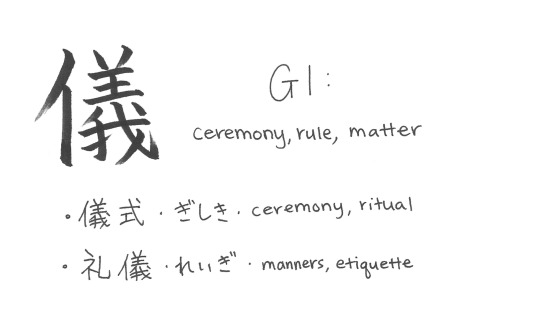

1252/2000
JLPT: N1
School Grade: Junior high school
This character is a combination of 亻 person and 義 righteousness. 義 is a phonetic element signaling the on’yomi, while also lending its own meaning. Here it also carries a connotation of “correctness” and “rationality.” Together with 亻, it gave a meaning of “righteous (correct) person,” and over time came instead to refer to “the ways in which a person becomes righteous.” This gives the current meanings of “rule/convention.” “Ceremony” is an associated meaning.
64 notes
·
View notes
Photo
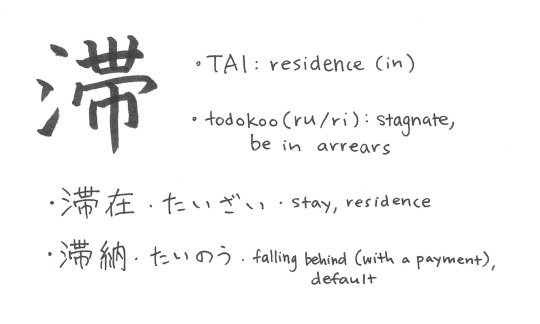

1251/2000
JLPT: N1
School Grade: Junior high school
This character is a combination of 氵 water and 帶/帯 belt. 帯 is a phonetic element signaling the on’yomi, but is also lending its own connotation of “contain/restrict,” and here carries a meaning of “stop.” With 氵 this gives “a flow of water stopped and unmoving.” It has come to mean “stop/stagnate” in a general sense.
#kanji#japanese#japanese language#japanese study#learning japanese#residence#residence in#stagnate#arrears#be in arrears#overdue#delayed#be delayed#stop#滞#1251#n1#junior high school
54 notes
·
View notes
Photo
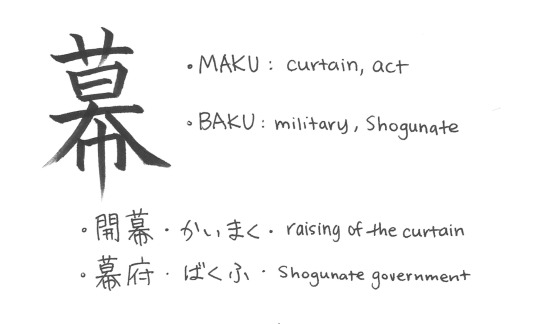

1250/2000
JLPT: N1
School Grade: 6th
This character is a combination of 莫 a non-general use character meaning “must not/do not/be not” and 巾 cloth. 莫 itself depicts the sun sinking among the plants, and carries a meaning of “conceal.” Here 莫 is a phonetic element signaling the on’yomi, but it is also working to lend its own meaning. Together with 巾 this gives “cloth which conceals,” or a “curtain.” The other meanings have all developed through association.
#kanji#japanese#learning japanese#japanese study#japanese language#curtain#act#tent#bunting#act of a play#military#shogunate#幕#1250#n1#6th grade
61 notes
·
View notes
Photo
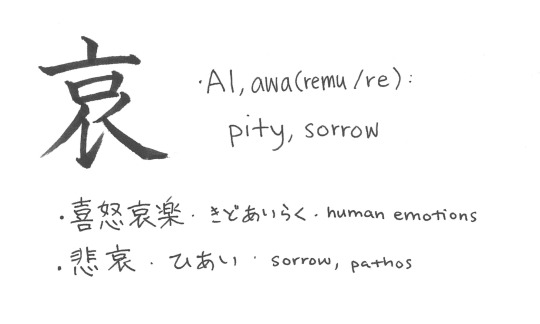

1249/2000
JLPT: N1
School Grade: Junior high school
This character is a combination of 衣 clothing and 口 mouth. There are multiple theories for the origin of this character. One is that it represents covering the mouth with a cloth, or, in a figurative sense, “covering/stifling one’s (sad) feelings/thoughts and keeping them inside one’s heart.”
#kanji#japanese#japanese language#japanese study#learning japanese#pity#sorrow#pathetic#grief#pathos#sympathize#哀#1249#n1#junior high school
67 notes
·
View notes
Photo


1248/2000
JLPT: N1
School Grade: Junior high school
Older forms of this character show that it was a combination of 虍 tiger, claw (backwards ヨ), and 几 (人) person. 虐 depicted a tiger catching/clawing a person, and came to represent “cruelty/brutality.” “Oppress” is an associated meaning.
#kanji#japanese#japanese language#learning japanese#japanese study#cruelty#oppress#tyrannize#虐#1248#n1#junior high school
54 notes
·
View notes
Photo


1247/2000
JLPT: N1
School Grade: Junior high school
This character is a combination of 而 and yet/but/however and 寸 measure/hand. 而 itself developed from the image of a beard, and here is being used to express that meaning. 寸 here means “careful use of the hand.” 耐 is a pictograph that referred to “shaving off a beard,” which was a minor punishment (the next level up was shaving the hair). This in turn symbolized something that was “not too bad” and “bearable.”
#kanji#japanese#japanese language#japanese study#learning japanese#endure#withstand#-proof#proof#enduring#bear#bearable#耐#1247#n1#junior high school
104 notes
·
View notes
Text
あけましておめでとうございます✨
120 notes
·
View notes
Photo
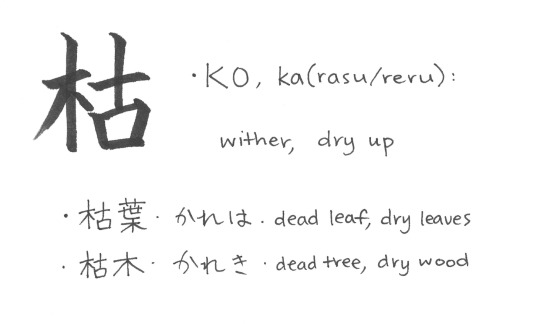

1246/2000
JLPT: N2
School Grade: Junior high school
This character is a combination of 木 tree and 古 old. Here 古 is a phonetic element signaling the on’yomi. Some say that 古 developed from the image of a skull, giving it a meaning of something hard and old. It is likely lending that connotation here, giving 枯 a meaning of an old, hard, dried up tree. This then symbolizes “decaying” and “withering” in a more general sense.
#kanji#japanese#japanese language#japanese study#learning japaneese#wither#dry#dry up#die#be seasoned#decay#枯#1246#n2#junior high school
48 notes
·
View notes
Photo
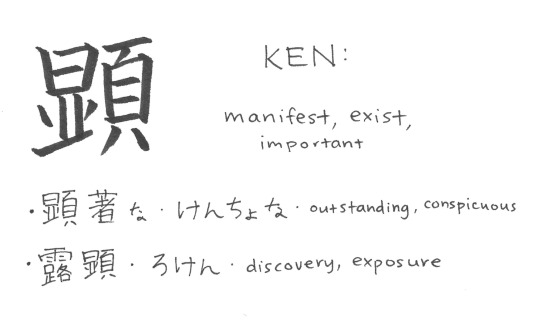

1245/2000
JLPT: N1
School Grade: Junior high school
This character was formerly written 顯, a combination of 㬎 a Chinese-only character meaning “motes (small particles of dust)” and 頁 head. 㬎 itself is a combination of 日 sun and 絲 threads. One source says that 㬎 represents laying silk threads out in the sun. With the addition of 頁, this gives 㬎 a meaning of putting ones face out into a bright place/the light of day, letting it be clearly seen. This led to the meaning of “visible” in general, and also “manifest.”
#kanji#japanese#japanese language#japanese study#learning japanese#顕#manifest#exist#important#appear#existing#visible#1245#n1#junior high school
99 notes
·
View notes
Note
do you use the app imi wa by any chance?
I do! Besides just using it in my own personal life (which I did a lot while I was in Japan... it saved my butt countless times lol), it’s actually one of the sources I check for the JLPT level and School Grade of each kanji. I’ll also put any meanings they list in the tags for each post.
32 notes
·
View notes
Photo


1244/2000
JLPT: N1
School Grade: Junior high school
This character was formerly written 緣, a combination of 糸 thread and 彖 a Chinese-only character meaning “pig/hedgehog.” Here 彖 is a phonetic element signaling the on’yomi, while also lending a meaning of “dangling edge” (from the image of a pig with a rounded, hanging stomach). Together with 糸 this gives “threads used for edging/hemming” or “threads used for decorating/embroidering the edges of clothes/cloth.” Over time 縁 came to mean “edge” in general. The meanings of “relations” and “ties” are thought by some scholars to be the result of borrowings.
#kanji#japanese#japanese language#japanese study#learning japanese#縁#relationship#ties#edge#rim#affinity#relation#connection#border#verge#brink#fate#1244#n1#junior high school
61 notes
·
View notes
Text
✨🎄✨🎁✨🎂✨メリクリ✨🎂✨🎁✨🎄✨
#merry christmas!#and happy holidays to everyone who doesn't celebrate christmas~#i should be back to posting regularly on monday!
54 notes
·
View notes
Text
Hi~ I’ve been feeling a little under the weather recently so I’m going to go on hiatus for a little while. Hopefully it’ll only be a week or so, but I just wanted to give you all a heads up!!
Stay safe!!! ♡
#i also had a terrible week at work#i've had such bad luck recently that my manager gave me two omamori to keep at my desk lol
46 notes
·
View notes